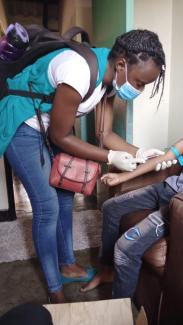Authors: Erin Berghammer USAID/Zambia, Godfrey Lingenda USAID/Zambia, Elizabeth Squire, OHA, Fruhar Safa, OHA
Zambia has made incredible progress in addressing the HIV epidemic since HIV first swept through the nation in the late 1980s. Zambia now has over one million people living with HIV on lifesaving antiretroviral treatment and is close to achieving the significant milestone of HIV epidemic control. HIV epidemic control is defined as having reached the UNAIDS 90-90-90 target, meaning 90 percent of people living with HIV know their status, 90 percent of people who know their status are accessing treatment, and 90 percent of people on treatment have suppressed viral loads. However, we also know that children, adolescents, and young people living with HIV still experience worse outcomes when compared to adults living with HIV. Globally, there are nearly two million children ages 0-14 that are living with HIV, but only 53 percent of these children are on treatment.
Because their immune systems are not fully developed, children living with HIV get sick more severely than adults and can’t fight off common infections as effectively. This is why it is critical that all persons living with HIV are able to reduce the amount of the virus in their body through adherence to treatment (antiretroviral therapy) so their immune system isn’t overly stressed. Viral load testing helps health workers to monitor how treatment is progressing in children living with HIV and enables them to make adjustments if needed to ensure that the child is able to reduce the amount of the virus in their body and stay healthy.
USAID’s Orphans and Vulnerable Children program, Empowered Children and Adolescents Program (ECAP) was created to support vulnerable families in Zambia, especially those most impacted by HIV, and to close the access gap for viral load testing for children living with HIV. In the first year of the program, a key barrier to viral load testing for children living with HIV was physically getting these children to the health facility for viral load testing. To address this key barrier, ECAP community case workers identified when children and their caregivers were available to meet for testing and began facilitating joint home-visits with clinical providers who were trained in phlebotomy. This helped to reduce the burden of reaching the facility such as: transportation costs, time off work, time away from school, and other barriers.
Trust (not his real name) is one of those adolescents who has received care through ECAP. Trust, a 17-year-old living with HIV, was enrolled in the program in March 2022. At the time of his enrollment, Trust had suffered from opportunistic infections due to a high viral load causing him to have low immunity to infections. Through ECAP, Trust was linked to a community case worker who put him on enhanced adherence counseling (EAC). The EAC sessions were conducted at Trust’s home and through these sessions it was discovered that Trust had stopped taking his medication.
The counseling provided to Trust and his caregivers through ECAP has been effective in getting him back on track with his treatment plan and improving his overall health. The case worker in charge of supporting his household continues to support Trust through regular phone calls and home visits. Through ECAP, Trust’s family has also been initiated into the “Small Livestock Pass-on” program for household economic strengthening.
“I'm very happy to have someone coming to rescue me. I had no hope to live longer with this status, but from what our interaction has been I feel I will make it. Thanks to you for your support,” says Trust.
Patrick (not his real name), a 16-year-old living with HIV, is another adolescent supported by ECAP. Patrick lives with his single mother and three siblings in an area that is over six miles away from his district’s hospital, the closest health center where he can access services for HIV treatment. Patrick uses a wheelchair and because of the distance to the hospital and lack of transportation, he is unable to get to his scheduled appointments. Patrick had missed critical drug doses as a result of missing his appointments, which led to his poor health and a high viral load that was not responding to treatment.
Through the ECAP program, Patrick has been able to receive his medication, has been screened for other diseases, has had his HIV monitored, and has been provided with EAC, all within the comfort of his own home.
"Kwena mwatwafwa, nga tatwakwanishe,” said Patrick’s mother, meaning “Indeed you have helped us, we wouldn't have managed on our own.”
In just the past six months, the ECAP program has actively facilitated over 1,415 viral load tests and provided care to more than 18,000 children living with HIV in 26 districts in Zambia. Today, the ECAP program continues to identify and connect with clients like Trust and Patrick who otherwise might not receive the critical HIV care they need. Through this work, we are hopeful that Zambia will soon reach HIV epidemic control and no other adolescent will be left behind.

USAID
